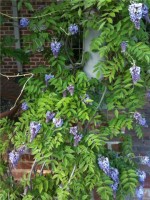
Wisteria is a woody deciduous vine sometimes grown as a shrub or tree. It is a member of the bean family, Fabaceae, that also includes peas, lupines, and black locust. There are three major species of wisteria that are cultivated in the US, two of which are introductions from Asia, Wisteria sinensis (Chinese wisteria) and W. floribunda (Japanese wisteria). American wisteria, W. frutescens, is native to wet forests, wooded swamps, and stream banks of the southeastern US, from Virginia to Texas, southeast through Florida, and north to Iowa, Michigan, and New York.
Description: The leaves are pinnately compound and the flowers are fragrant, peas-like, and produced in dense pendent clusters in spring. They may be white to pink or lavender and give way to large bean-like pods that have a velvety coat and contain several lima-bean sized seeds.
Poisonous Properties: All parts of the plants are poisonous with the seeds and seed pods being the most toxic, but not fatal. The toxins are a glycoside, wistarin, and a poisonous resin, lectin that irritate the digestive system causing nausea, abdominal pain, vomiting, and mild diarrhea. Symptoms usually last about 24 with complete recovery